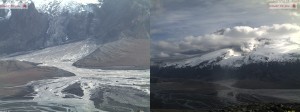When the Hawaiian phase of the eruption in Eyjafjallajökull volcano finished many people did believe and think that the eruption in Eyjafjallajökull volcano was over for a long time. But they where to proven wrong about 23:30 UTC on the 13. April 2010 when a new phase started in the Eyjafjallajökull volcano eruption. For the first few hours of the eruption nothing did happen on the surface. As the eruption had to melt the glacier that was on top of it. That did finish around 06:00 UTC on the morning of 14. April 2010 and the eruption broke up to the surface around that time.
The eruption up to this day had just been Hawaiian type eruption with slow moving lavas and with little to no volcano ash at all. The second phase of the eruption in Eyjafjallajökull volcano was mostly of Strombolian type of eruption. With little to heavy ash fall. But in the early start of the eruption and specially when a water got into the crater the ash fall was heavy. The volcano ash cloud did at it’s highest peak go up to 10 km high.
This eruption in Eyjafjallajökull volcano is not among the Iceland biggest or the longest one. But during the six weeks of eruption it did manage to shut down Europe air-space down to Spain creating a billion euro worth of pure loss to the economic in Europe. But the ash fall did not just create problems in Europe. In Iceland farmers living close to the Eyjafjallajökull volcano got there own share of problems. Most of the problems where due to the ash fall (A video player that can play wmv file required) and the flooding that took place around Eyjafjallajökull volcano that took place because of the melting glacier on top of Eyjafjallajökull volcano.
Other things that where seen in this eruption in Eyjafjallajökull volcano was a smoke ring, something really rare and most often found in Etna volcano in Italy. But shock waves where also seen and heard across Iceland during this eruption. But it was also recorded when the eruption was throwing up large rocks from the main crater. Some people also made really cool videos of the eruption. Here is one of it.
Among the many things that did happen was the fact that a lava did flow into the glacier and destroy the glacier in the process. This happening in a eruption in Iceland had not been recorded or observed until the eruption in Eyjafjallajökull volcano in the year 2010.

Picture of the Eyjafjallajökull volcano smoke ring. Picture captured from Vodafone IS web cam that was observing the eruption. Copyright of this picture belongs to Vodafone IS. Click on this picture for a full size.
Update: A meeting at University of Iceland tomorrow since it has been one year since the eruption in Eyjafjallajökull volcano.
Tomorrow from 17:00 to 19:00 UTC at Askja, room 132 and central space. Please see the pdf file for more information about this even. I was asked by a geologist working at University in Iceland to publish this here for anyone how is interested in going to this event.
Eyjafjallajökull one year on at University of Iceland
Click to read this pdf file.

